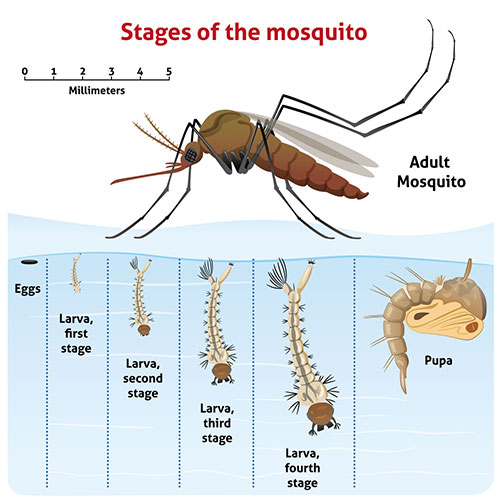I’m sure everyone reading this has encountered at least one of these pesky pests before. Today, I’m writing to tell you more about these pests, what we can do, and why we should care about them. While these insects and arachnids play an important role in the food web, they are also vectors of disease. By sucking blood they can transfer different viruses and bacteria from their saliva or last blood meal to you! Gross, right? Their ability to transfer diseases from one animal to another makes them “vectors”. The best way to reduce the different diseases mosquitoes and ticks cause is to reduce the number of vectors, or try to protect yourself from coming in contact with them.
Mosquitoes:
Mosquitoes are a type of fly, or two winged insect. Mosquitoes can carry diseases like Eastern equine encephalitis (aka Triple E), West Nile virus, and malaria. However, we can’t completely remove mosquitoes from the environment because A. that would probably be impossible, and B. we don’t know all the side effects that could have on the ecosystem. Mosquitoes are an important food source for fish, bats, and dragonflies. They may also play a role in pollination of some plants as mosquitoes mainly feed on flower nectar – they only need to eat blood to lay eggs (USDA). However, you can still reduce the number of mosquito encounters you may have!
In order to control mosquitoes around your living area, it is important to remove any standing water that might exist in your yard. It’s possible that you may have left out a bucket, barrel, or some other yard work item that is now collecting rainwater. That uncovered rainwater is a perfect habitat for mosquitoes to lay their eggs and subsequently for young mosquitoes, or larvae, to grow and develop. These places are especially great for mosquito larvae because they lack the mosquito’s natural predators such as fish and the young, aquatic dragonflies and damselflies, or nymphs. To reduce the amount of mosquitoes in your yard, one of the easiest things you can do is to dump out these buckets and try to remove places where water can collect. Before you dump out those buckets, do a little citizen science for NASA! NASA needs people on the ground to find evidence of mosquito habitats to support the mosquito habitat predictions they are able to make from satellite data. All you need to do is go to their website and download their GLOBE Observer app for more information.

(All of the mosquito larval stages with a size comparison to an adult mosquito – if you have any standing water in your yard you might notice these tiny wriggling larvae in the water! Photo from: Control Household Pests)
There are also natural methods that will help you control the mosquitoes in your area. As mentioned above, dragonflies and damselflies and their young nymphs are mosquito-eating machines! As nymphs, they devour as many larvae as they can catch – if you check out the PBS Deep Look video below you can see just how good they are at hunting mosquito larvae. And as adults, the dragonflies and damselflies zoom around your yard munching up mosquitoes and other pesky flies. So if you see dragonflies or damselflies in your yard, don’t squish them! They’re on your side. Bats are also excellent bug eaters and will remove many mosquitoes from your area, so be kind to bats as well. You could even support local bats by installing a bat house in your yard – more info on that below as well (Merlin Tuttle Bat Conservation).
Other actions that you can take to protect yourself are all fairly straightforward: try to reduce the opportunities that mosquitoes have to come in contact with you.
- Put screens in your windows to keep mosquitoes and other flies out.
- If you happen to be out in a swampy area, or an area with a lot of mosquitoes, try to wear protective bug netting or long sleeves.
- Use an insect repellent. If you’re not sure what repellent to use, the EPA has a website that offers recommendations based on your needs.
These steps should all reduce your risk of getting bit by mosquitoes.
Ticks
Everyone loves going outside and going for a walk on a beautiful spring, summer, or fall day. No one likes to think about the ticks that may be lurking on the blades of grass, waving their eight little legs in the air hoping to snag your shoes or pants. But they certainly are out there! And their bites can cause complications like Lyme disease (CDC). Thankfully, there are some very easy steps you can take to protect yourself from these awful little hitchhikers!
- Wear light colored clothing – especially your pants! This will make it easy to spot any creepy crawlies you might pick up on your hike.
- Use insect repellent rated for use against ticks! This will make ticks less likely to find you.
- Treat any outdoor pets with flea and tick medication, making sure to follow your vet’s advice. This will stop your furry friends from bringing ticks into your home.
- After hiking or yard work, throw your clothes in the dryer on high heat for at least 10 minutes – ticks can’t survive being dried out!
- While you’re at it, take a shower after you hike. This will wash any unattached ticks off of you before they get a chance to bite you.
- Check yourself for ticks! As the CDC states, “Ticks can attach to any part of the human body but are often found in hard-to-see areas such as the groin, armpits, and scalp.” (CDC)
- If you find a tick attached to you, use tweezers to pinch it as close as you can to your skin and pull it straight out. Keep an eye on the area for a few days to make sure it does not become infected. Also save the tick in a ziploc bag just in case you need to have it tested for the Lyme-causing bacteria by your doctor.

(Source: “Borrelia bavariensis: Vector Switch, Niche Invasion, and Geographical Spread of a Tick-Borne Bacterial Parasite” Borrelia is the Lyme disease causing bacteria)
Deer, white-footed mice, and ticks thrive and overlap in areas called edge habitats. These habitats are created when two different types of habitat meet, like a forest suddenly opening up to a field. In particular, these three animals are worth keeping an eye on because they all play an unknowing part in the spread of Lyme disease, which was first studied and identified right here in our own state. The white-footed mouse acts as a perfect host for young ticks, unfortunately it may also carry Lyme disease-causing bacteria. The mice and deer tend to spend time in the same edge habitats, making the edge habitats an ideal spot to stay for any tick looking for a new host.
When things like construction and tree removal increase the number and size of edge habitats the chances that a tick can find a new host significantly increases too, meaning an increase in the tick population overall, which is not great for us humans. This also means more opportunities for people to come in contact with ticks that have Lyme-causing bacteria on the edges of their yards, fields, and forests. By leaving trees and reducing the borders of forests and fields, there will be less habitat that allows for the multiplication of ticks. Deer population control will also reduce the amount of ticks in the habitat. It is vital to also recognize that at any point this cycle, a tick that is carrying, or a vector for, the Lyme-causing bacteria could attach to a person and spread Lyme disease.
I hope the information here helps you protect yourself against my least favorite outdoor critters! Remember to bring bug spray on your outdoor adventures and always always check yourself and your clothing for ticks! Please check below for some of my favorite resources on these common pests.
Other Resources:
SciShow – What if We Killed All the Mosquitoes? And 5 Things that Make You a Mosquito Magnet – I always seem to be the one to get bit by mosquitoes on hikes with friends and I frequently wonder in those moments, what if we killed all the mosquitoes?
PBS Deep Look – A Baby Dragonfly’s Mouth Will Give You Nightmares – A fascinating look at how dragonfly and damselfly nymphs catch mosquito larvae.
Dr. Merlin Tuttle’s bat conservation website with more info about building a bat house for your yard.
Ologies by Alie Ward dives into tick biology and gives everyone her very best advice on how to prevent tick bites in an interview with a scientist who studies ticks – an acarologist! She also interviews a disease ecologist to understand the diseases that ticks carry and how that works. Please be aware that Ologies episodes tend to contain inappropriate language and references.
NPR’s series Patient Zero Podcast follows the history of Lyme disease – how it was first found and recognized as a disease and where we are today in Lyme disease research.
One of my favorite episodes of Radiolab, Alpha Gal, the story of how a woman developed a meat allergy.
Tick Encounter from the University of Rhode Island will help you identify your tick and offers tick testing services for a fee with Tick Report run by University of Massachusetts Amherst.
Stay connected! Be sure to subscribe to Down to a Science— The Official Blog of the Connecticut Science Center and follow us on social media.

Jessie Scott is a STEM Educator who enjoys encouraging students’ enthusiasm for science. She teaches classes to students visiting the Science Center and brings STEM lessons to schools across Connecticut. Jessie completed her Master of Science degree in Microbiology at Dartmouth College and worked as a science educator at the Montshire Museum of Science before coming to the Connecticut Science Center. Her scientific interests are: biology – how living things have adapted different strategies to survive in their environments, insects, and plants. In her free time, Jessie likes to go rock climbing, hiking, and skiing.



